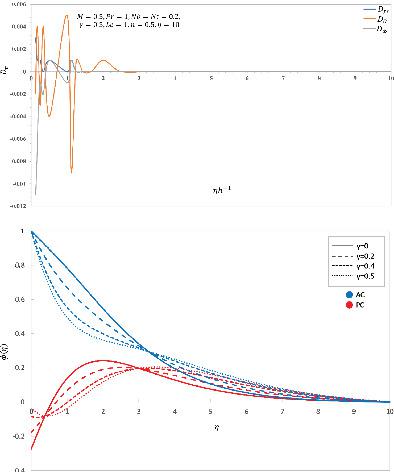当前位置:
X-MOL 学术
›
Int. J. Numer. Methods Fluids
›
论文详情
Our official English website, www.x-mol.net, welcomes your
feedback! (Note: you will need to create a separate account there.)
On a new block method for an MHD nanofluid flow with an exponentially decaying internal heat generation
International Journal for Numerical Methods in Fluids ( IF 1.7 ) Pub Date : 2020-12-23 , DOI: 10.1002/fld.4953 I. S. Oyelakin 1 , O. Adeyeye 2 , P. Sibanda 1 , Z. Omar 2
International Journal for Numerical Methods in Fluids ( IF 1.7 ) Pub Date : 2020-12-23 , DOI: 10.1002/fld.4953 I. S. Oyelakin 1 , O. Adeyeye 2 , P. Sibanda 1 , Z. Omar 2
Affiliation

|
This study is an investigation of an exponentially decaying internal heat generation rate and free nanoparticle movement on the boundary layer. The equations describing the hydromagnetic flow and heat transfer in a viscous nanofluid moving over an isothermal stretching sheet are solved using a novel numerical approach. A comparison of flow and heat transfer characteristics between an actively controlled (AC) and a passively controlled (PC) nanoparticle concentration boundary is considered. The boundary value partial differential equations are transformed into a system of ordinary differential equations using similarity transformations. The system of ODEs is solved using a new block method without having to reduce the equivalent system to first‐order equations. The solutions are verified using the spectral local linearization method and further validation of the results is confirmed by comparing the current results, for some limiting cases, with those in existing literature. The solutions obtained using the block method are in good agreement with the solution obtained using the spectral local linearization method. The results are in good agreement with existing findings in previous studies. The solutions obtained using the AC and PC nanoparticle concentration boundary conditions are analyzed.
中文翻译:

关于具有内部衰减的指数衰减的MHD纳米流体流的新阻止方法
这项研究是对内部生热速率和边界层上自由纳米粒子运动呈指数衰减的研究。使用新颖的数值方法求解描述在等温拉伸片上移动的粘性纳米流体中的水磁流和传热的方程式。考虑了主动控制(AC)和被动控制(PC)纳米粒子浓度边界之间的流动和传热特性的比较。使用相似变换将边值偏微分方程转换为常微分方程组。ODE的系统使用新的块方法求解,而不必将等效系统简化为一阶方程。使用光谱局部线性化方法验证了解,并通过将当前结果(在某些局限情况下)与现有文献中的结果进行比较,进一步证实了结果。使用块方法获得的解与使用光谱局部线性化方法获得的解非常吻合。结果与先前研究中的现有发现高度吻合。分析了使用AC和PC纳米粒子浓度边界条件获得的溶液。结果与先前研究中的现有发现高度吻合。分析了使用AC和PC纳米粒子浓度边界条件获得的溶液。结果与先前研究中的现有发现高度吻合。分析了使用AC和PC纳米粒子浓度边界条件获得的溶液。
更新日期:2020-12-23
中文翻译:

关于具有内部衰减的指数衰减的MHD纳米流体流的新阻止方法
这项研究是对内部生热速率和边界层上自由纳米粒子运动呈指数衰减的研究。使用新颖的数值方法求解描述在等温拉伸片上移动的粘性纳米流体中的水磁流和传热的方程式。考虑了主动控制(AC)和被动控制(PC)纳米粒子浓度边界之间的流动和传热特性的比较。使用相似变换将边值偏微分方程转换为常微分方程组。ODE的系统使用新的块方法求解,而不必将等效系统简化为一阶方程。使用光谱局部线性化方法验证了解,并通过将当前结果(在某些局限情况下)与现有文献中的结果进行比较,进一步证实了结果。使用块方法获得的解与使用光谱局部线性化方法获得的解非常吻合。结果与先前研究中的现有发现高度吻合。分析了使用AC和PC纳米粒子浓度边界条件获得的溶液。结果与先前研究中的现有发现高度吻合。分析了使用AC和PC纳米粒子浓度边界条件获得的溶液。结果与先前研究中的现有发现高度吻合。分析了使用AC和PC纳米粒子浓度边界条件获得的溶液。










































 京公网安备 11010802027423号
京公网安备 11010802027423号